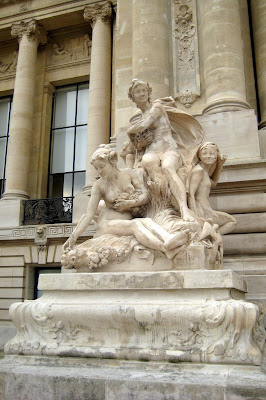 Louis Convers' Les Quatre Saisons sits outside the main entrance to Petit Palais. The Petit Palais was originally built, like the Grand Palais, its counterpart across the street, for the 1900 Universal Exhibition (World's Fair) in 1900 to the design of Charles Girault. Originally meant to be just a temporary structure to host a large exposition of French art, the Beaux-arts building became such a favorite with Parisians that it was never demolished. Today it houses the Musée des Beaux-Arts de la Ville de Paris. Following a four-year renovation by Phillipe Chaix and Jean-Paul Morel, the Petit Palais reopened to the public in 2005.
Louis Convers' Les Quatre Saisons sits outside the main entrance to Petit Palais. The Petit Palais was originally built, like the Grand Palais, its counterpart across the street, for the 1900 Universal Exhibition (World's Fair) in 1900 to the design of Charles Girault. Originally meant to be just a temporary structure to host a large exposition of French art, the Beaux-arts building became such a favorite with Parisians that it was never demolished. Today it houses the Musée des Beaux-Arts de la Ville de Paris. Following a four-year renovation by Phillipe Chaix and Jean-Paul Morel, the Petit Palais reopened to the public in 2005.In classic Beaux Arts style, the Petit Palais combines Greek and Roman forms with largescale ornamentation. Ionic columns and a grand porch open up the westward entrance facing Avenue Winston Churchill. A dome stis atop the trapeze-shaped monument, echoing that of the Invalides across the river. The entire design is laid out around a central semicircular courtyard and garden. Girault's interior design was greatly influenced by Italian art.
The current exhibits are divided into sections: the Auguste Dutuit Collection of medieval and Renaissance paintings, drawings and objets d'art; the Tuck Collection of 18th century furniture and the City of Paris collection of works by French artists, such as Jean Ingres, Eugène Delacroix and Gustave Courbet. Collection highlights include Poussin's The Massacre of the Innocents, Ruben's Prosperpina, and Rembrandt's Self-Portrait with Poodle.
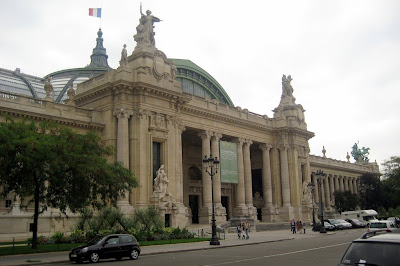 The Grand Palais (Grand Palace) was originally built, like the Petit Palais, its counterpart across the street, for the Universal Exhibition (World's Fair) in 1900 to the design of Charles Girault. Closed for 12 years for extensive restoration work after one of the glass ceiling panels fell in 1993, it reopened in September 2005. Temporary exhibitions are in the Galeries Nationales du Grand Palais.
The Grand Palais (Grand Palace) was originally built, like the Petit Palais, its counterpart across the street, for the Universal Exhibition (World's Fair) in 1900 to the design of Charles Girault. Closed for 12 years for extensive restoration work after one of the glass ceiling panels fell in 1993, it reopened in September 2005. Temporary exhibitions are in the Galeries Nationales du Grand Palais.The exterior of this massive palace combines an imposing Classical stone facade with a riot of Art Nouveau ironwork, a glass roof, and Georges Récipon's statues of flying horses and chariots at its four corners.
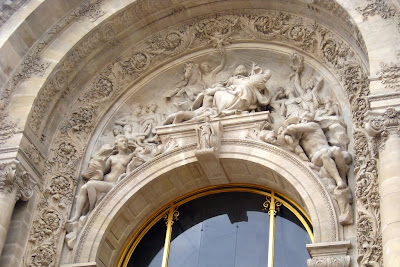 Antonin Injalbert's high relief, la Ville de Paris protégeant les Arts (The City of Paris Protecting the Arts), surmounts the main entrance to the Petit Palais. The Petit Palais was originally built, like the Grand Palais, its counterpart across the street, for the 1900 Universal Exhibition (World's Fair) in 1900 to the design of Charles Girault. Originally meant to be just a temporary structure to host a large exposition of French art, the Beaux-arts building became such a favorite with Parisians that it was never demolished. Today it houses the Musée des Beaux-Arts de la Ville de Paris. Following a four-year renovation by Phillipe Chaix and Jean-Paul Morel, the Petit Palais reopened to the public in 2005.
Antonin Injalbert's high relief, la Ville de Paris protégeant les Arts (The City of Paris Protecting the Arts), surmounts the main entrance to the Petit Palais. The Petit Palais was originally built, like the Grand Palais, its counterpart across the street, for the 1900 Universal Exhibition (World's Fair) in 1900 to the design of Charles Girault. Originally meant to be just a temporary structure to host a large exposition of French art, the Beaux-arts building became such a favorite with Parisians that it was never demolished. Today it houses the Musée des Beaux-Arts de la Ville de Paris. Following a four-year renovation by Phillipe Chaix and Jean-Paul Morel, the Petit Palais reopened to the public in 2005.In classic Beaux Arts style, the Petit Palais combines Greek and Roman forms with largescale ornamentation. Ionic columns and a grand porch open up the westward entrance facing Avenue Winston Churchill. A dome stis atop the trapeze-shaped monument, echoing that of the Invalides across the river. The entire design is laid out around a central semicircular courtyard and garden. Girault's interior design was greatly influenced by Italian art.
The current exhibits are divided into sections: the Auguste Dutuit Collection of medieval and Renaissance paintings, drawings and objets d'art; the Tuck Collection of 18th century furniture and the City of Paris collection of works by French artists, such as Jean Ingres, Eugène Delacroix and Gustave Courbet. Collection highlights include Poussin's The Massacre of the Innocents, Ruben's Prosperpina, and Rembrandt's Self-Portrait with Poodle.
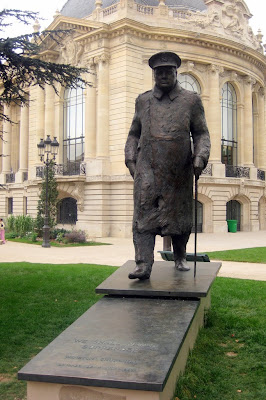 The statue of British Prime Minister, Winston Churchill, by French sculptor Jean Cardot was erected in 1998 on the corner of (appropriately) avenue Winston Churchill. It is modeled on a photograph of Churchill marching with General Charles de Gaulle down the nearby Champs Elysees on November 11, 1944.
The statue of British Prime Minister, Winston Churchill, by French sculptor Jean Cardot was erected in 1998 on the corner of (appropriately) avenue Winston Churchill. It is modeled on a photograph of Churchill marching with General Charles de Gaulle down the nearby Champs Elysees on November 11, 1944.The 3.2m high statue is made of bronze and weighs 2.5 tonnes. The plinth bears his immortal words: "We shall never surrender."
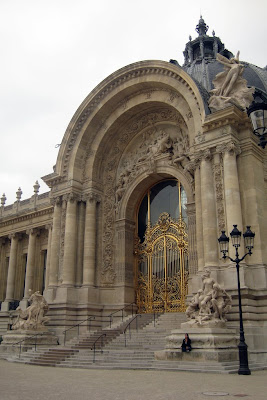 The Petit Palais was originally built, like the Grand Palais, its counterpart across the street, for the 1900 Universal Exhibition (World's Fair) in 1900 to the design of Charles Girault. Originally meant to be just a temporary structure to host a large exposition of French art, the Beaux-arts building became such a favorite with Parisians that it was never demolished. Today it houses the Musée des Beaux-Arts de la Ville de Paris. Following a four-year renovation by Phillipe Chaix and Jean-Paul Morel, the Petit Palais reopened to the public in 2005.
The Petit Palais was originally built, like the Grand Palais, its counterpart across the street, for the 1900 Universal Exhibition (World's Fair) in 1900 to the design of Charles Girault. Originally meant to be just a temporary structure to host a large exposition of French art, the Beaux-arts building became such a favorite with Parisians that it was never demolished. Today it houses the Musée des Beaux-Arts de la Ville de Paris. Following a four-year renovation by Phillipe Chaix and Jean-Paul Morel, the Petit Palais reopened to the public in 2005.In classic Beaux Arts style, the Petit Palais combines Greek and Roman forms with largescale ornamentation. Ionic columns and a grand porch open up the westward entrance facing Avenue Winston Churchill. A dome stis atop the trapeze-shaped monument, echoing that of the Invalides across the river. The entire design is laid out around a central semicircular courtyard and garden. Girault's interior design was greatly influenced by Italian art.
The current exhibits are divided into sections: the Auguste Dutuit Collection of medieval and Renaissance paintings, drawings and objets d'art; the Tuck Collection of 18th century furniture and the City of Paris collection of works by French artists, such as Jean Ingres, Eugène Delacroix and Gustave Courbet. Collection highlights include Poussin's The Massacre of the Innocents, Ruben's Prosperpina, and Rembrandt's Self-Portrait with Poodle.
No comments:
Post a Comment